#theatre performance
Text
had a breakdown today at a theatre competition because I couldn't tear a piece of tape . theatre is fun life is good
btw this was when we we're spiking the set not while we were performing
21 notes
·
View notes
Text

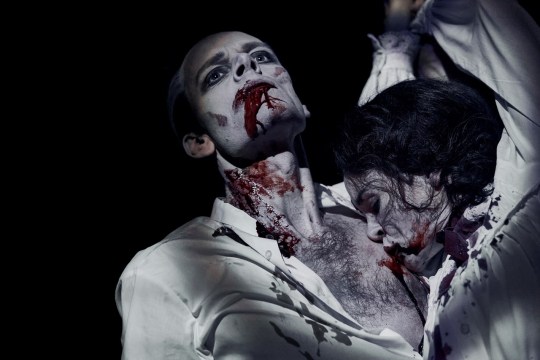

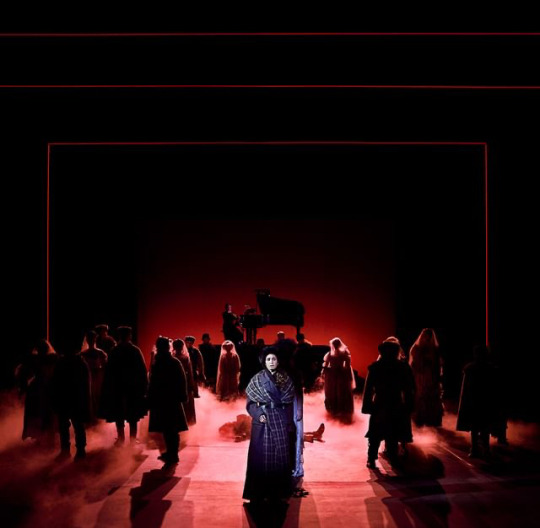

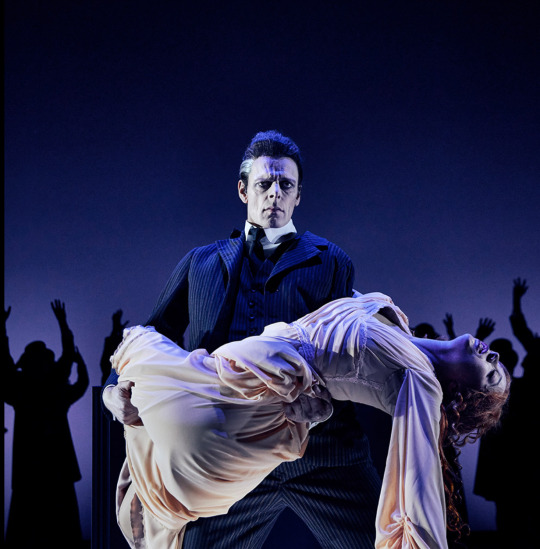

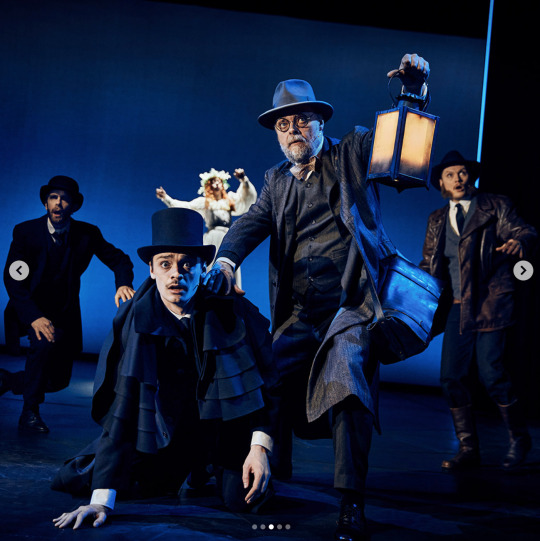
Aarhus Teater's performance of Dracula in collaboration with Den Jyske Opera - Review
Photographs from Aarhus Teater's instagram and website by emiliatheresephotography.
Review:
my dear dad spoiled me rotten by taking me to see the performance of Dracula at Aarhus Theatre which I have waited for since 2020, but like so many other things that year, covid put a pause on production and postponed the premiere until 2023.
Vampires as we know are hard to kill and I have no hesitations in saying it was well worth the wait to see this musical theater performance resurrected.
As the lights die down and the audience becomes silent, a thrill of anticipation for the gruesome adventure we’re all about to embark on sweeps through the dark auditorium like a haunting gush of cold wind. In walks a tall, pale, skinny man, dressed in a simple black Victorian suit. He’s got no fangs, no black and red velvet cape, but he carries himself with the aristocratic self-confidence and superiority we’ve come to recognize Dracula for. He’s shrouded in a single spotlight making him the only thing jumping out from the dark stage. Slowly he raises his hand and with a swift drop of his finger, he cues in a single haunting note. He raises the other hand to pull out another note. Slowly he conducts a haunting melody and is soon joined in by an operatic choir. The singers, dressed in old dark Victorian costumes, appear in the doorways on the balconies amongst the audience and we all realize that for the next two hours, we are entirely in the grasp of Dracula's cold dead hands. And thus the scene is set for a fantastic musical gothic theater performance.
Martin Lyngby who directed the play says that in his adaptation there is an attempt at creating room for reflection in the story. He wants to make visible perspectives that might be hidden from the characters themselves and to see them in the context of how those perspectives have changed a lot since Stoker's time. This to me is incredibly exciting since I believe this interpretation is very much aligned with my thesis on Dracula. Dracula himself in this play is a villain as we know him. He’s not a hideous monster but he is selfish, fiendish, something old that modern society has long outgrown. He’s the fear of the foreign, of infection and degeneration. Like the book, he isn’t present in the story all that much but the play perfectly articulates how his presence looms around the characters at all times even if he is not physically there. The conductor metaphor from the opening scene is played throughout the whole play and in certain scenes, Dracula is present on the stage as an observer or to simply visualize how he is always present in the minds of the people he infects. The adaptation also really capitalizes on the sensual and sexual of the vampiric both in the blood transfusions but also in the blood-sucking and how the blood is the life. What stood out to me most about this illumination of perspectives is how it is made explicit how ignorant the heroes are to their own sexualization of Lucy but also the harm they do to Mina in their patriarchal foolishness. Or rather how that perspective of theirs actually stands in the way of what they’re trying to achieve.
This was neither an opera nor a musical. The creators themselves describe it as musical theater. The composer Marcus Aurelius Hjelmborg created a captivating soundtrack by remixing old historic pieces, especially requiem hymns, and songs about death and blood. He uses the well-known “Dies Irae” as a theme throughout like a red thread. He’s got Mozart's “Requiem” but also something as old as Hildegard Von Bingen’s “O Rubor sanguinis” from 1130. The earliest piece is from 1890 and it adds an extra texture not just to the fact that Dracula as a story is over 100 years old but also to the oldness of vampires. The music is continuously used to create texture throughout the whole play. It is used to ornament the atmosphere, it creates the gothic where the scenography remains simple and clean. The music is what decorates so to speak. I did find the scenography genius in its simplicity however. Backdrops with lighted edges were used to force perspective and make the characters seem trapped or shrink. Lightboxes lowered down from the ceiling were used to symbolize Dracula's 50 boxes of dirt. A large set of stairs with a grand piano on top was often used to envision landscape or Dracula’s castle. The only real scenography the actors had to interact with was an office that could be raised from the floor and a bed.
One of the coolest and most terrifying scenes in the play was Lucy’s death. Obviously, that part of the book is special to me because I’ve spent so much time analyzing it. I was really curious to see how it had been interpreted onto the stage. Here Lyngby’s modern context comes to play again as it illustrates how our heroes in their patriarchal ignorance are quite terrifying. Lucy is held down by the three men on an illuminating box. Van Helsing narrates the events that take place while she struggles and screams in their hold. Blood starts spilling from the ceiling landing right on Lucy’s chest and as she lies there fighting for her life her white dress gets more and more soaked in blood. In my opinion, this scene perfectly captured the underlying implications of rape and general invasiveness of the female body there is in the Dracula text.
The story was constructed in an interesting way where instead of going in chronological order like in the book it was split up going back and forth in the timeline to piece together the story sort of like a mystery. I think this was done to make it more interesting to follow and to hone in on Mina’s role as the one who orchestrates the coherency of the story. However, I believe this didn’t always serve the best purpose for the story. I think people who haven’t read the book jumping around in time might make it harder for some to follow the narrative.
In an attempt to pay homage to the source material and adhere to the diary format of the book the whole play was sort of narrated by the characters reading the various diary entries. They would speak out the diary entries written in past tense and then act it out as they were speaking. An example of this would be the three proposals. Lucy tells Mina what happened but as she narrates, the three proposals happen in real-time on stage. The narration would be shared between actors, so whenever one of the suitors in Lucy’s narration would say something they would take over the narration for her but not just to speak out dialogue, they would continue her narration, speaking their dialogue in paraphrase like: “he got down on one knee and told me that he really cared for me”. I thought this was a very cool and fun way to play with the original material. Whenever Dr. Seward would speak his phonograph entries; they had a voice-altering effect that made it sound phonographic, which was another nice way of performing the diary entry elements. However sometimes, especially in some of the action sequences, this technique didn’t work for me at all. The whole last fight of the story was also narrated this way by different actors speaking what they were doing but without actually doing it. It happened in an imaginative plane where the actors did symbolic gestures to emphasize what was happening. The final fight with Dracula was essentially just him walking down the large stairs up the stage to the front and then when he “turns to dust” in the narrated speech from Van Helsing, Dracula just steps aside to the left of the stage. This made sections that were mostly performed in this manner a little boring and anti-climatic for me.
The ending still captivated me though (spoiler alert!). Dracula has been told and retold almost to pieces at this point so Lyngby cleverly decided to give it a new ending which again fits into how he really centered the story around Mina and her agency. Rather than the original ending where Mina is saved and Dracula’s curse on her is lifted, she takes over the conducting when Dracula dies as if the torch has been passed on to her. She enters the castle and she feels at home, feels she belongs. This ending could be interpreted in a number of ways but I choose to see it as an act of liberation where Mina has gained total freedom. I could probably write several more pages on why I think that is but my review is already too long so I’ll leave it at that.
Final thoughts:
In conclusion, I thought this was magnificent and captivating. I feel lucky to have experienced one of my favorite books put to life on stage like this. The criticism I have comes purely from the fact that I have such a deep passion for the source material and really in the grand total of things the parts I disliked are rather minor.
#cold reviews#theatre performance review#theatre performance#dracula#dracula theatre performance#vampire reviews#musical theatre#vampire theatre#tw blood#tw rape
1 note
·
View note
Text

The 2023 American Girl Doll of the Year is Kavi Sharma, a South Asian American theatre kid who loves Wicked SO SHE HAS A REPLICA ELPHABA COSTUME. I am absolutely ecstatic that kids get this.
edit: SHE ALSO HAS A GLINDA COSTUME


SHE ALSO HAS THIS!! BECAUSE SHE PERFORMS A TRADITIONAL DANCE ROUTINE WITH HER FRIENDS AT SCHOOL AND SHE LOVES BOLLYWOOD
#as someone that dressed up as (specifically wizard and I) elphaba (but bought a witch hat so people would know who I was)#this would make middle school me so incredibly excited#the costume was designed in collaboration with Wicked!!#the day Broadway has a South Asian performer play Elphaba I fear I will combust out of joy#desiblr#musical theatre#overjoyed that I get to use those two tags in conjunction with one another#wicked#ozposting#American girl dolls are soooo expensive though which is a bummer
3K notes
·
View notes
Note
just saw asteroid city last night, pls explain the proposed significance of the kiss!!
answering this publicly hope thats ok! cant do a readmore im on mobile *****asteroid city spoilers below beware*****
i dont remember anyones names so this is gonna sound partly unhinged. okay so the edward norton playwright and jason schwartzman actor (not character, in the black and white parts) are lovers right. tbh i thought this was kind of a gag and forgot about it. but later we find out that the playwright died 6 months into the production. i didnt make the connection that THAT’s why the actor-jason has to suddenly leave the stage and freaks out backstage about how he’s not sure he’s Doing it right. hes not talking about acting!! because he himself is literally grieving his lover while he’s playing a character who’s grieving his wife written by his lover so obviously it’s too much!!! actor-jason is trying to find meaning in his death through his writing but there isnt any meaning in death [gerris drinkwater voice] which is what the play is trying to say anyway. he doesnt think he’s performing grief right even in his own life!!! (and tbh it’s the 50s so he wouldnt be able to perform grief publicly anyway!!!!) the play starts with a car accident… anyone would search for some hidden meaning there, some sign…. so when he talks to margot robbie outside it’s not really about finding the CHARACTER’s motivations it’s about the actor himself being able to process the playwright’s death! and adrien brody director was probably also dealing with that too (him and norton seemed to be good buddies) so the whole “sleeping backstage” thing gets a bit sadder maybe? maybe everyone else got this in the theatre and im just stupid lol but crazy making stuff to me!!! the whole story is about sublimated gay grief that cannot be expressed?!?!
the tweet that caught me onto this was here which posits that the playwright’s death was a suicide but i think that’s pretty stupid and unnecessary because the whole thing about the play asteroid city is that death is random and meaningless. im pretty sure that’s what the alien represents— a shocking and absurd event that isnt outright evil or menacing, not something anyone can predict or make sense of, it’s just a thing that happens to you out of nowhere, it doesnt mean anything. he’s a little black figure, he’s death! giving and taking! aagh
#you’re the wife who played my actor :(#posthumus#asteroid city#imagine youre in love with a playwright and he writes a play before he even meets you about how you cant get over his death which hasnt#happened yet. id go insane too#im going to see it again to see how this informs the whole thing because its driving me crazy#rewatching the performances knowing that they're performing people performing. augh.#remember when bryan cranston accidentally appears in frame. rending my garments#also ‘you cant wake up until you fall asleep’ confused me a bit but then i remembered that the margot robbie scene was supposed to be put o#as a dream sequence and it makes sense now. thanks#aliens are the new fairytale monster symbol of death. the ultimate Unknowable#EDIT okay i read the wikipedia summary got some facts wrong adrien brody is sleeping in the theatre during rehearsals so its not because of#the playwright’s death he’s just like that.
2K notes
·
View notes
Text
little girl, a patient: can I have a lollipop
doctor merlin in the 21st century: can you have— I have created butterflies from nothing and horses from smoke. I have seen empires rise, fall, crumble, and start from nothing but a fish in a poor man’s hand. I’ve fought witches and failed them too. I’ve laid waste to armies and blessed nations of people with health that will never make up for it. I have pantsed Kings and kissed Queens. I have stood upon the precipice of this world and called forth the ocean only for time to swallow me whole and spit me back out. And I would do it all again if I could grant you, dear Matilda, a lollipop.
little girl: strawberry?
merlin: say no more, Tilda, this should clear up the taste of that cold medicine right away
#bbc merlin#Merlin#merlin emrys#listen.#Merlin being a doctor on and off throughout the entire time he’s had to live meand a LOT to me#especially if he were a GP (general practitioner) in the 20th/21st centuries#like a local doctor of a small town or village#(it’s actually what he is in my farm au)#nebulously this is part of#the sun room#‘verse#I just think he’d have the best time being the eccentric fun doctor to kids#distracting them with wild tales that are very true (though only he knows this)#the parents - and other patients - think he’s a little crazy in an endearing way#that or he must have once wanted to perform theatre or musicals right???#merlin like yeah ok that’s more believable than the lie I was going to fail at#works for me#merlin headcanons#merlin au
749 notes
·
View notes
Text
AU where Phoenix is a drama teacher and Edgeworth is an English teacher and they’re both really weird about Shakespeare
Or
drama teacher!Phoenix and dance teacher! Edgeworth have to work together for a high school play without trying to kill each other (it gets real fuckin close)
#I’ve seen Phoenix as an art teacher which is great but that guy would make an excellent drama teacher#he’s so silly#the essence of narumitsu is giving these guys essentially the same job but keeping them as petty haters#also I feel like only the gayest people are drama and English teachers#anyway every AU where phoenix is doing theater stuff is my favorite#I think that he and Trucy would bond over being performers and I kinda want to have fun with it rather than be sad with it#I think they should join a community theater program and not tell anyone during the 7yg#it would be funny#narumitsu#wrightworth#phoenix wright#miles edgeworth#ace attorney#edit: I haven’t been in any sort of theatre program in like a decade and I miss it
267 notes
·
View notes
Text

Waiting for Godot, a herald for the Theatre of the Absurd. Festival d'Avignon, dir. Otomar Krejča, 1978.
#theatre of the absurd#absurdism#performance#theatre#70s#otomar krejča#waiting for godot#black and white#monochrome#photography#u
167 notes
·
View notes
Text

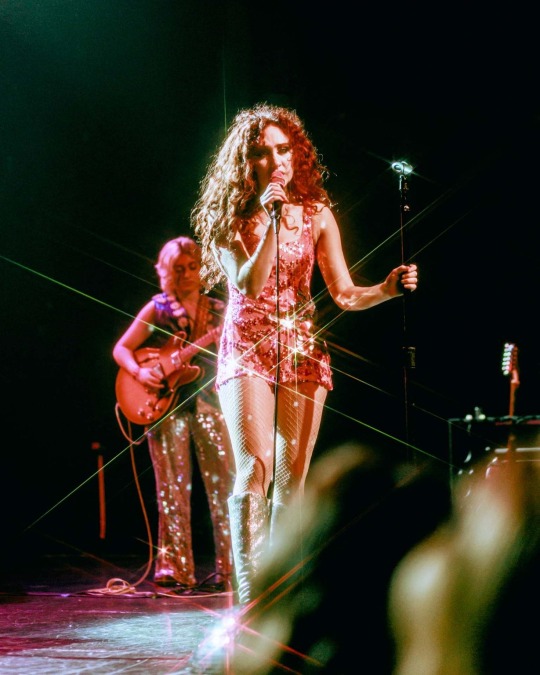
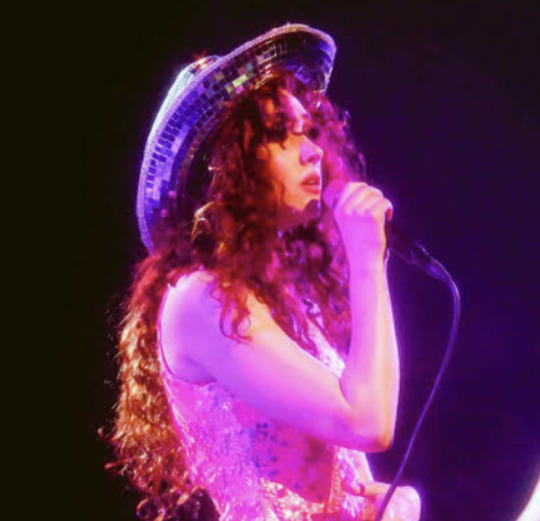
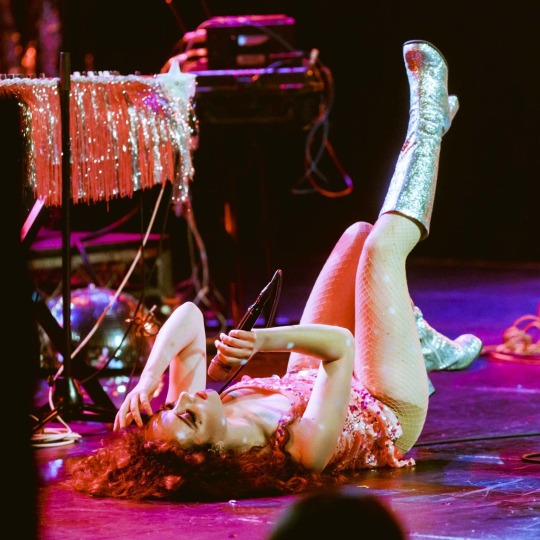
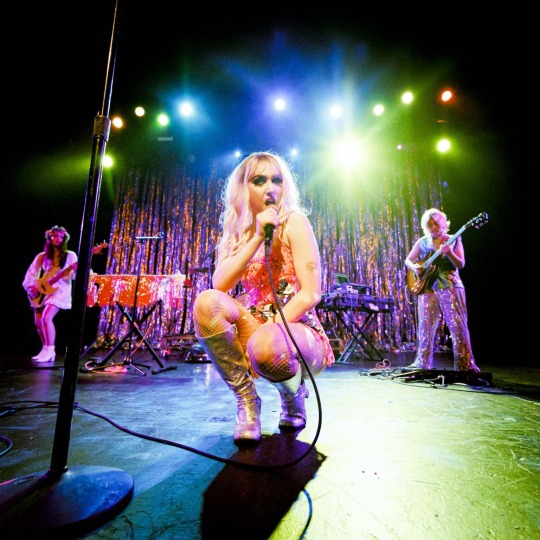

chappell roan at the fonda theatre, los angeles
#chappell roan#fonda theatre#los angeles#chappell roan live performance#concert#california#naked in manhattan#love me anyway#coffee#bitter#hot to go!#kaleidoscope#casual#my kink is karma#mine
165 notes
·
View notes
Text
I need to watch Sharpay's Fabulous Adventure to reach my final conclusion on if she's even attracted to men
#girl help i keep thinking about sharpay and ryan being each others only friend growing up#theyre not very good at interpersonal relationships#romance is foreign to them. they dont care about playing romantic interests because they only view romance through the lens of theatre#fake. not real. an act to entertain an audience. so they dont understand why it would be weird#neither of them have ever kissed anyone#sharpay likes things that make her look better#because her whole life is a performance#so she wants troy because hes a shiny accessory to her#thinking about hsm 2 where once again when she tries to perform a romantic song (with troy this time and not her brother)#she still barely fucking looks at him#all of her attention is on the (nonexistent) audience#and ryan. ryan hm#ryan usually performs alongside sharpay#its usually an in universe performance. theyre on a stage. theres an audience#and all of his attention is on pleasing that audience#an exception to this is during the gay baseball song#where theres a different kind of audience BUT#ryan barely looks at them#most of his attention is directed solely to chad#talking flirting teasing being cocky and annoying but clearly addressing him directly through most of the song#first time this has happened with ryan. take that as you will#ANYWAY i can see sharpay as completely uninterested in romance but she hasnt realized that about herself#and she THINKS she wants it. because she sees it as glamorous#or maybe shes a lesbian i dont know#she might be a lesbian#the deciding factor is sharpays fabulous adventure#if she has chemistry with the guy in that movie then shes just repressed and clueless#if she doesnt shes aro#or possibly lesbian
106 notes
·
View notes
Text

the kink got out of hand, sorry

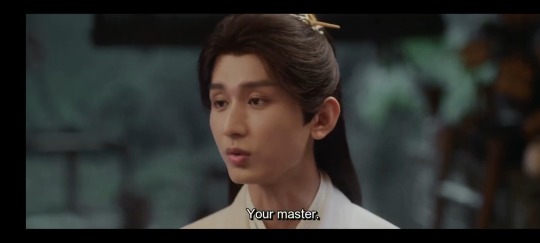
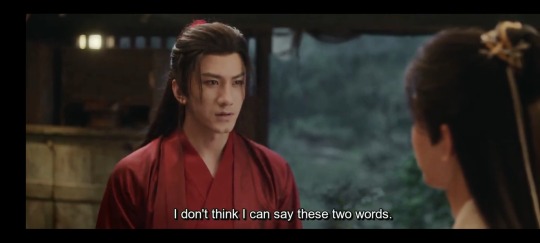
then what ARE the words you want to say
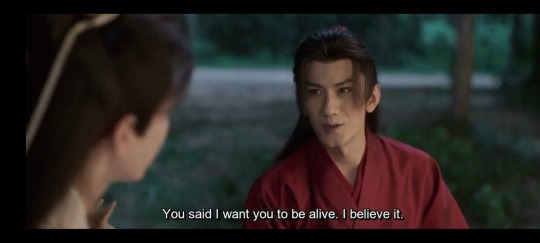
I can't believe they really went with "antagonist gets amnesia, vaguely recognises the protagonist and decides that they are besties actually" trope
#being silly to distract myself from the pain#li lianhua#di feisheng#mysterious lotus casebook#mlc#kk's liveblog tag#(I don't want to think about llh's impending death tyvm)#(deeply fascinated by him going ''yeaaaah. Have A-Fei perform on the streets'' this fucking guy.#llh is a true theatre kid with how many random tragic backstories he makes up. Yeaaaah your life was so tragic I rescued you and told#You to save people to repay the debt. Then you got captured and what not etc etc)#''people say 10 lies a day'' is a statistical error. Lying Georg who says 10000 lies per day shoudl not have been counted#dihua#<= is that their ship name?
93 notes
·
View notes
Text
RAHH FINISHED MY THEATRE COMPETITION PERFORMANCE
we did "any body for tea" by C.B. Gilford
I played the roll as "miss birdie"
we won 2 honorable cast mentions for "miss hildegard" and "miss amantha"
we won first place for tech
we scored an excellent on all the categories except physicality (we didn't act like old ladies)
but HELL YEAH we did good even though we didn't place cuz my school haven't won since 2013 😭🙌 I'm tired as hell
#theatre#theatre performance#theatre tech#theatre kid#theater#any body for tea#theatre competition#competition
5 notes
·
View notes
Text
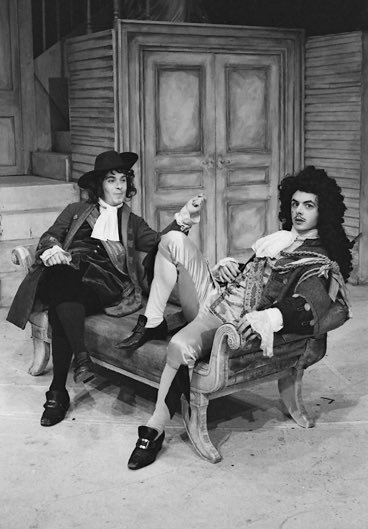
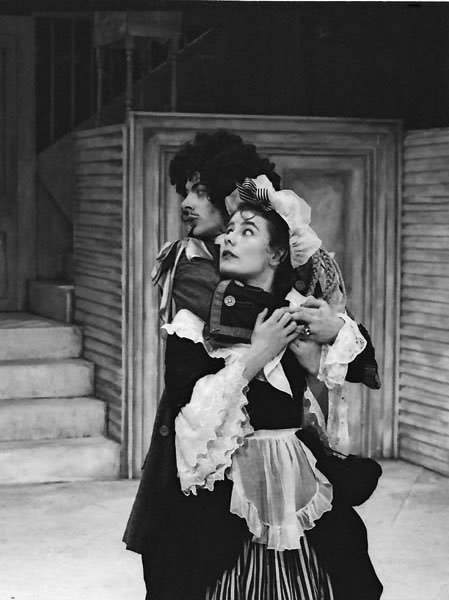
ya'll.
107 notes
·
View notes
Text

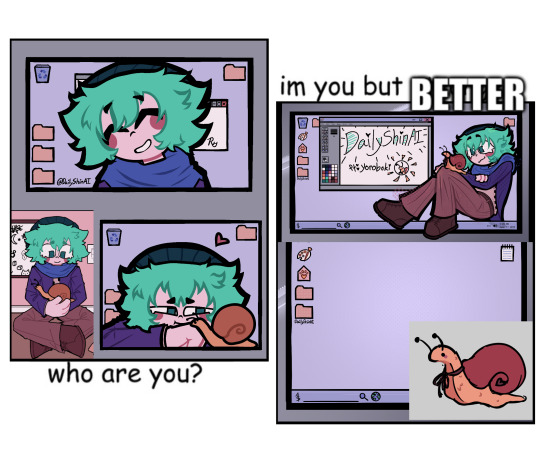
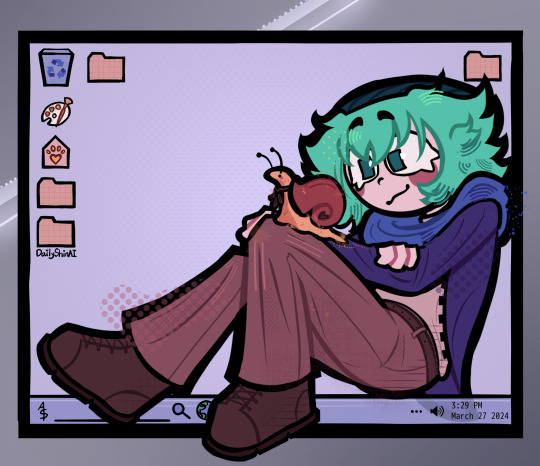
Day 83: Banner and background revamp + Yoroboki redesign!!
dailyshinai blog gets a glowup?! [NOT CLICKBAIT]
discord emoji
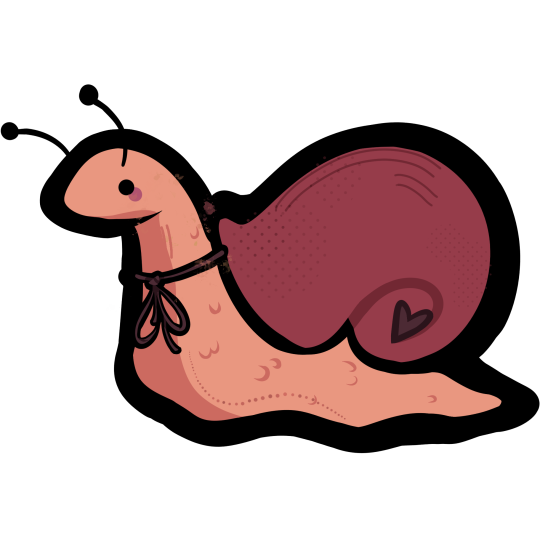
#finally got un-sick and finished theatre performances#anyway#i’ve wanted to re design Yoroboki for so long :sob:#do you like him :3 (you better)#fun fact!! Yoroboki is actually just a slug but wears a snail shell and wants to be a snail#daily shin ai#runes art#yttd#your turn to die#shin ai#kimi ga shine#shin tsukimi#sou hiyori#yttd fanart#shai#yoroboki
67 notes
·
View notes
Text
WAD reflection from the perspective of a theatre director
Inspired by @/calvinahobbes who did an amazing job breaking down the show’s metaphors & using her English degree in this post, I wanted to share my perspective on it (even a month later) & get use out of my theatre degree lol. Also, warning, this will be very much a long, long essay with run-ons. I have ADHD & I love when my frequent hyperfixations intersect 🤪 There are major spoilers.
My Background:

I am a semi-professional theatre director, but more broadly, a theatremaker. I have a theatre degree from New York University’s Tisch School on the Arts (NYU Tisch), where I did a conservatory program with one of their studios which focused basically on those who wanted to do a little bit of everything and create new works & was the only studio training directors & playwrights. I originally went into the program as a performer. I did not mean to end up concentrating on being mainly a producer & a director, but that’s a whole other story. I also through that program had to take theatre/performance studies courses, which I loved for the most part & is an interesting interdisciplinary field. But I will try to define terms just in case since anybody reading this may not know any or all the specific terminology I might use. In short, I have a fancy degree that apparently should cost $300k 🤡 & I’m gonna actually use it with doing this lol
--
Setting the Tone:
While Dan might call this a comedy special or comedy show, and thereby comparing it to other comedians, I actually think he is doing himself and We’re All Doomed (WAD) a disservice. I saw folks compare him a lot to Bo Burnham in the chat (who was actually was accepted and almost went to NYU Tisch for a different studio that focused on solely experimental work), which makes sense considering the theatrical nature of both of them. However, Dan actually goes further into the realm of theatre because of how he utilizes his crowd work (I’ll go into that later). I recognize traditional comedy specials/standup as having jokes or stories, when doing you know like late night talk show interviews, that can be made outside of the context of the show & slip into a conversation. Or with Burnham’s Inside Out, the songs & other parts can be done or understood mainly out of context, as seen through Bo uploading them to his YouTube channel. Comedy specials have the sections of their comedy stand-up thread together, but what Dan has done is weave his sections together. The length along with the intermission/interval being a part of WAD, adds to my point that he is not treating this as different material he tested out at different comedy clubs, but as something cohesive storytelling pieces. I think in terms of testing, Phil was the main sufferer audience member of the initial materials being created.
Anyway, you cannot as easily remove it from the context at certain points, because the transitions & the order of these different sections are treated as equally important, rather than a means to move on to the next section, with some possible space for improv.
Basically, I’m bi. Sorry, my brain started thinking about BIG when I started writing “basically” at the start of that sentence. Actually, what I am trying to say is that I would classify We’re All Doomed as a one-man performance piece/show, so I will be treating it as such in my review/reflection/breakdown. The comedy of it is important and there, but I don’t think it captures what WAD entirely is.
Also, unfortunately due to where I was at mentally at the time & the location it was being performed at, I never saw this live. To be honest, how it got framed marketing-wise did not help me feel connected with the actual purpose of the show, with hope being a key element. So while this was filmed, I am as much as possible trying to remove the cinematography as an element of my analysis. However, some things might be clearer on film, as with theatrical directing, you cannot add a zoom or crop & instead are trying to ensure moments are clear to an audience by what they see and hear through drawing their attention to it. With theatre being mainly about the live output by performers and intake by the audience, at the end of the day, what my job as a director is is to direct not only how the performers share the story, but also direct the audience on what is important to catch for understanding.
--
Breakdown of Thoughts
Originally, I wanted to rewatch the show again, and started to, but considering I ended up writing about a whole page worth of things for each minute of the show & I was sleepy by the time I was like 5-10 minutes in, I decided to be nice to myself & stay up all night in my comfortable bed instead of staying up all night at my desk trying to take in-depth notes 🙃
I’m gonna breakdown this analysis/reflection into further sections, just to give myself some anchors & break up the blocks of text. Also as a way to just be that pretentious, maybe with an academic flair, as is fitting to be for something about Dan Howell (said affectionately 💕)
The Script/Writing
When considering the text of the show itself, two things came to mind for me:
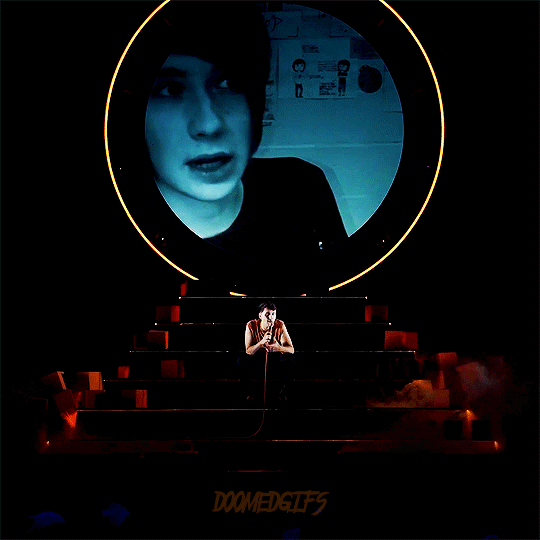
(1) This is definitely what I would call intertext. Intertext is a piece of writing that relates to another or more other writings through allusions. WAD is an intertext which alludes mainly to other works of Dan’s on his YouTube channel. The ability to get the true impact of the show relies on you knowing Dan (as his internet persona) on some level. And as a theatre maker & longtime fan, I love that it is, it’s what the piece needed to be. As a theatre producer, the hiatus from engaging with his audience and the limited runway given to reactivate interest in him and his creative work I think made it difficult to get that audience in some venues, along with some other funkiness (mainly with promo) I am less knowledgeable on. But I think Dan has already learned/continues to learn from that, which I think may have been valuable for him. (sidenote: I need the tea on all that because I love knowing how presenting venues work with performers, as well as the lack of understanding they have of internet culture as it relates to venue leadership.)
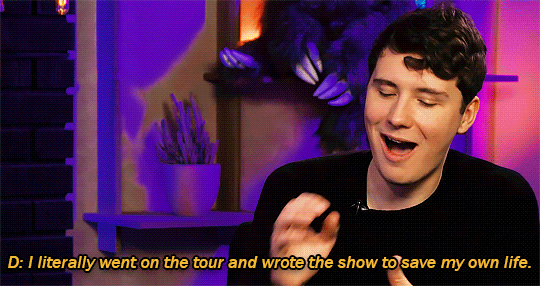
(2) This was a work he made for himself. He mentions this both in the show & in reference to WAD multiple times. But I think what truly came to mind for me was that it is still powerful for him to write for himself. He is writing for what he needs to be hearing or wants to be processing creatively.

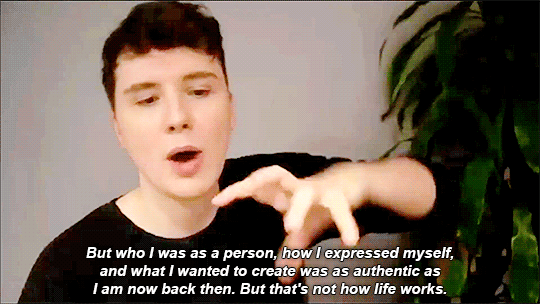
I think why it is powerful is that Dan has discussed before how much stress he put on himself regarding danisnotonfire, and later Daniel Howell, videos, focusing on the audience, and how he was presenting a specific style/quality of video to them. Add in the layer of being closeted & actively fighting internalized homophobia, and the anxiety he built up makes sense. And I might personally attribute that more to his need to pass as straight & catering I believe at one point to an audience of cishet men, whether actual or perceived by him. Not all videos, especially the most impactful ones in my opinion, rely on this, but it was a key piece of what he made during his rise in popularity on the platform. This catering slowly decreased with the amount of uploads he was doing, along with a more tangible understanding of his audience thanks to the tours he did with Phil. Basically I’m Gay I think was the true shift where he gave himself permission to write work that had a main audience of himself. That’s where his best work has come from, and I think since then, he’s been able to have the space to process things creatively through his writing.
--
The Relationship Between Performer & Audience
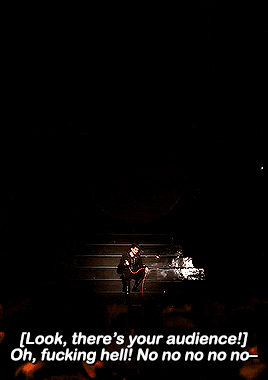
When I was in theatre school, my directing teacher would constantly talk about not just considering the relationship of the performers on “stage” (I did a lot of more immersive work & we only had black box theatres, which is literally a room that is floor to ceiling black) but also the relationship of the performers & the story with the audience. By Dan knowing mainly who his audience would be, the show can now play with that understanding in mind.
This leads to my point that, overall, Dan does not use the fourth wall, and I think that is what makes We’re All Doomed work. It may also be why he called it a comedy show, idk.

For those who don’t know what the fourth wall is, it is a term from theatre originally that is about the way in which a traditional theatre stage (called a proscenium) has three physical walls around it, while there is no 4th physical wall, so the audience can see the performance. If does exist physically, it is only the curtain that acts as the 4th “wall”. So, in order to keep it as a separation between the performers and the audience, the actors treat the side where the audience is as a fourth wall. When someone breaks the 4th wall, this is when they speak to audience directly, rather than to another character. Examples from English-speaking pop culture would be the asides from Hamlet or Ferris Bueller in Ferris Bueller’s Day Off. But when you are the only person on stage, the only way to have a fourth wall is when you don’t reference that you know there’s an audience there. Hence, a monologue where the character is talking to themselves or an entity that is not the audience directly (or assigned to be the audience by the director), it is the closest you can have a fourth wall when alone.
Dan in his videos and in his previous tours with Phil never were without direct engagement of the audience (obvious with the naming of Interactive Introverts). It was never not a variation on him speaking with the audience in any type of dialogue, even if done parasocially.
Some of that is not new to theatre, but I would say is that it has become more of a trend within new theatre starting in the early 2010s to have more interactivity and a more authentic, explicit message that no performance will be the exact same. I definitely saw that in the shows I saw both Off-Broadway (which sidenote, all that means is that there’s fewer seats in that theatre, not about quality of the work or how worth it is to engage with) and larger settings like Broadway and the West End. That’s what I love about theatre, and why my own work is more about immersion and direct audience engagement.
Now Dan’s creative works have never been skit only or interested in telling a story outside of the realm of connecting with an audience as a variation of himself, so again, him not using the fourth wall overall is appropriate and fits in with what I mentioned about intertext. The piece does however start with a fourth wall for the music number, which I will walk through fully sharing why I am saying that about the song & dance opening after establishing some other concepts to help build understanding.
--
Design Can Work With You or Against You

I just want to say out the gate that the design was done really well, and I immediately felt a need to emphasize it after watching the first 10 minutes again.
First, let’s talk about the orange & black aesthetic of the show. Dan may have simply said that the orange just looked cool, but I think I would attribute more meaning to that color. Orange brings to my mind at first instance both a bright happiness/warmth and a sense of caution and warning, like road signs (at least those in America). The themes of the show reflect these two ideas and plays with the tension between them. I don’t know if he or the team meant to have that be a conscious choice, but there’s a joke I’ve had with other directors of when they get complimented on something unexpected, they just nod and say “yes, that was a choice”, even though it was just a random thing that happened or was something that you just thought would be cool to do. Orange runs through the show’s designs and it becomes clear that it is a tool for contrast and emphasis for the points Dan & the director want to make.
Now with the design team of costumes, lights, sound, and media, I can see a clear cohesion. Good theatrical design has the designs act as a character or highlighter in the story. Bad theatrical design can take away/distract from the core intensions of the show. It was so clear to me that the design was a character. And seeing that there were two media designers make complete sense considering the labor lift of both creating the projections displayed, but also creating/filming pieces of the media itself. The music/sound and lighting work well to articulate the manic feelings it means to instill in the audience and seeing it as a director, I assume part of the creative discussion was about parts of the media played they wanted to make sure were heard, and the lights help catch attentions in service of those pulled out moments. For costumes, I think Calvina did well in her post at articulating the elements of the costume and the progression it goes throughout the show. I’d rather not take up space to say the same thing truthfully.
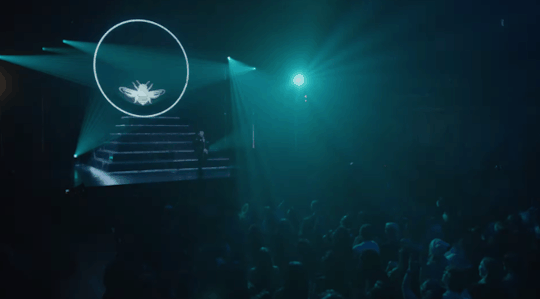
With all the design elements, I think three characters could be defined (not including the audience), two as main characters, and one as a supporting character. I would name the main characters as “the Circle” (the looming set piece throughout hosting the projections used throughout) and “Dan On Stage/Dan performing” (the one in the physical space) with the “voiceover Dan/inner voice Dan” as a supporting character. The voiceover only exists in the beginning, and it is only shared with us to demonstrate the way in which the Dan On Stage singing is not really that aggressively optimistic and wholeheartedly believes the words he is singing. He is not the Dan we know from the Internet, so we can cathartically laugh at the attempt to pretend everything is fine. The voiceover only has one role, and it is to force Dan to confront this breakdown has an audience.
--
Staging an Opening Sequence: Our First Stage Character is the Circle

In directing classes, often what you focus on is called stage pictures, which is meant to help you consider what the actual imagery you want to ensure the audience absorbs for their understanding of the piece. The first and last stage moment of each act should tell a basic story of what happened, and therefore, are heavily emphasized as important for directors. The Circle (capitalized for reference purposes) being lit up before the show starts and then again in conjunction with the light flashes and sound establishes the importance of the Circle to the show. When the projection comes into play, showing the speech of a 15-year-old Greta Thunberg before beginning to add more, we are then introduced to the purpose of the Circle to be an output/portal for the overstimulation of messages, in this case, I would claim it being what comes from the Internet.
The music/sound and lighting work well to articulate the manic feelings it means to instill in the audience and seeing it as a director, I assume part of the creative discussion was about parts of the media played they wanted to make sure were heard, and the lights help catch attentions in service of those pulled out moments. The Circle also through some of the lighting moments, mimic that of a clock, which again adds to the doomsday, the "end is near" type energy. To have the end of the opening sequence build to an explosion which then shows solid orange at the end while Dan is in silhouette begins the introduction to the orange emphasis & proposes a sort of prophet-like version of him after the apocalyptic imagery disappears as he rises to be seen. What we have opened with is setting the tone to how we should view these two characters of the Circle & the Dan on Stage.
--
Song Time!

Dan is such a theatre kid & I love that for him. His dramatic side shows through the moment he used a rise to start his show at the top of the stairs, first in a place of seriousness with the sharp lighting and smoke to then bring in a very happy music number. The contrast & switching of expectations is a key of comedic works, and shows through most of the phandom who did not know WAD started with that, as it is indeed funnier if it comes as a shock. The movement & music mimic what folks attribute to as musical theatre, which is campy, happy singing. Knowing he was the one who suggested the song for TATINOF, I am loving Dan clearly wanting to have that opening number of a musical moment, even if it is dripping in irony. The Circle & the lights in this acts as a supporter to the message of it being sunshine and rainbows, with literal rainbow lights included. (Sidenote: I am 99% sure the pigeon coo is Phil, so if anything, I’m disappointed he was not credited as Pigeon sound effect AND remote crisis manager. Idk why I could tell, but both times now, it’s what I immediately thought when hearing that part)
I think of the musical number as the only place where he does have a fourth wall, because the number does not directly reference the audience at the start. It’s a one-man moment and it is about the performance not the audience engagement. It starts falling away when he starts pointing out the “and you”s, but the voiceover is the real break in our understanding of the world. It is emphasized by the color inversion of the sun & sky media of the Circle. The director is saying, this is important to how you now interpret what you’ve seen & will see, this is another shift from what was established of this world.
I should mention “world” is the terminology used to name what the environment the story is being told in with consideration, especially in theatre, of how much of a need there is for suspension of disbelief. I believe this term is also referenced a lot when discussing the fantasy and sci-fi genres, since those also requires some distancing from reality for the audience. This ties into a phrase I will probably end up using a lot of “rules of the space”. When establishing this world for the show you are presenting to an audience, there is a type of logic that must be established in order to understand what is the baseline for what the audience will be engaging with over the span of the show. But the voiceover immediately changes the rules of the space, because it messes with the Dan on stage, and messes with the messaging of the Circle. It adds a new context to the Dan On Stage, as while a fan will know that this song is not in alignment of our knowledge of Dan Howell, we get confirmation that this indeed ironic and outside of the branding that Dan has boxed himself into over his time on YouTube.
But the voiceover is also not in alignment with that “branding”. It expresses concerns related to the Dan On Stage’s mental wellbeing. There is no irony or subtext in that voice, it is the most direct in speaking to Dan On Stage, because it is being said by a variation of Dan in voiceover to himself. These could be seen as questions he knows to ask himself, but as someone who advocates for mental health & shares now about being openly gay, I interpret that he may feel he cannot express that outside of his mind for fear of undermining his advocacy points. The discussion of the “wonders” of the Internet also continue building in the tension that exists throughout WAD of how Dan feels about that space. The voiceover then proposes at first a type of equal extreme, which only sees the Doom, and as someone with clinical Depression myself, I think is only a furtherance of the breakdown, rather than the reality check it started off being. Not that what is listed is wrong by any means, but the barrage of it is meant to expand the drowning feeling, not act as call to action or consideration of the intricacies for engaging in the world. With the Circle’s sun imagery & the music having been inverted and shifted to something more sinister, Dan’s movement up the stairs fits a type of circular moment from the first entry of him, where the image of the prophetic figure is questioned on how he alone will solve the climate emergency. The slap & break of character for the Dan on Stage serves to confirm our understanding of the voiceover as the voice in Dan’s head & indeed there are not two Dans.

Also, the sparklers 🎇 showing up really make the key change for the song, but my producer brain is going, “girl, of course you lost money on this show, was that so VERY NECESSARY?” But the dramatic Gemini theatre bitch in me would 100% want this too. I just don’t have a capita£ester working to get sponsorship money in my life, so I have to be reasonable 😔 Also, the confetti with the high note is peak theatre gay so I again, love that for him. And of course, the confetti is orange.
--
Hints of Orange

When the song reaches its end & the Circle starts showing squares of orange, rather than a full background, this acts as a seed for the breakdown and waterfall of cubes, which Calvina speaks to the orange cube hint at the beginning in her post. The sudden cut-out with Dan simply lit replicates a moment the Circle is not present. The Internet is not present. To crawl to a microphone, the message is not “hey this guy needs two mics”, because we see one on his face, but that the wired mic (which I will now label as “The Microphone”) is a metaphor. It’s a crawl towards sharing out, not suppression. Only when the voiceover of himself points out the audience does he does a full fourth wall break. The suppression did not work, and neither he nor the audience can believe that it was the Truth.
The wire of the Microphone being orange showcases that it was meant to be seen. I don’t think it even in play in terms of the sound, like it might not even be on, considering the feedback nightmare it would likely cause. And no standard microphone used on stages has orange wires, because that would pull the audience’s eyes to it. But that’s the point here.

The rules of the space are now this: the Circle is not always active, the Microphone has significance, the Dan On Stage knows there is an audience. None of these were true before, even the Circle was on before the start. This draws the audience to know there has been a shift & to have the first words said into the Microphone be “We’re All Doomed” solidifies the song moment was a blip, that this is really where we start at. As an example, in the social media section, Dan does a deliberate wrapping of the wire on his hand at the same time the Circle scrolls to the social media icon. It is how the director & Dan are ensuring that we understand “what he is saying and what is been shown on the screen are in tandem”, so if you’re paying attention to that wire, it signals you should look up too.
Every other prop, except I believe the gavel and wig, is also orange. The bubble gun is mainly what comes to mind for me, since the cubes are not as activated as props necessarily. But if an item is to enter the stage, what I interpret it as is that it must be orange, there must be high contrast, nothing in the physical world on the stage can become blurred, only screens have that privilege(?) to have things blend together.
--
The Power Struggle Between Dan & the Circle
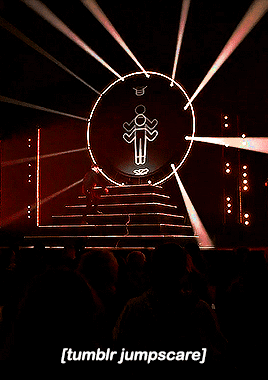
Once Dan has begun directly conversing with the audience, the rules of the space are:
(1) Dan On Stage acts, the design elements react (not including the Circle)
(2) The Circle and Dan have a symbiotic relationship, as neither have complete control over the other & react to what each other are doing
(3) The icons are our guides in understanding the sectioning done throughout the show
(4) Having “One Good Night” is the goal to reach at the end of the piece
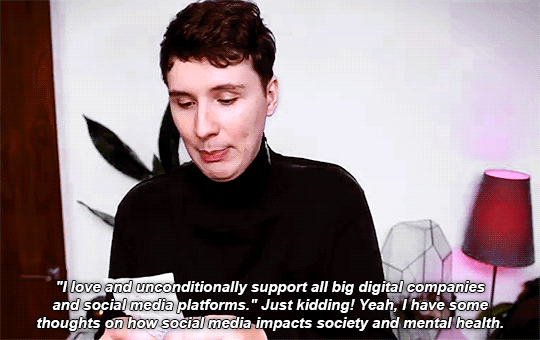
As a person, as well as discussed throughout the show, we know that Dan has a contentious relationship with the Internet. It is what has given him his living but has also caused some of his worst moments mentally (2012? I don’t know her). It is the space in which lets him have an audience who have mainly showed him support, but also the space that has fed the cynicism that fuels his clinical depression. There lies in the way in which the Circle exists on the stage & looms over Dan in the background. It’s a necessary evil of what appears on the screen.
Why do I then say that the design elements are reacting? Well, if we remove the Circle from the equation, the lights, sounds effects, and props are all cued off of something Dan does like the clown honk. However, the Circle sometimes cues off what Dan does, but sometimes instigates what Dan speaks to. That especially is evident when video clips play that invoke what media Dan has been contending with on the Internet and the consequences of those things.
The Circle exists throughout both Act One & Act Two, but only becomes passive to the piece when Dan directly shows vulnerability & the removal of protective irony. Calvina spoke to this when discussing the costume choice of him opening the jumpsuit in Act Two to show the orange tank underneath.
--
Cubes as Articulators
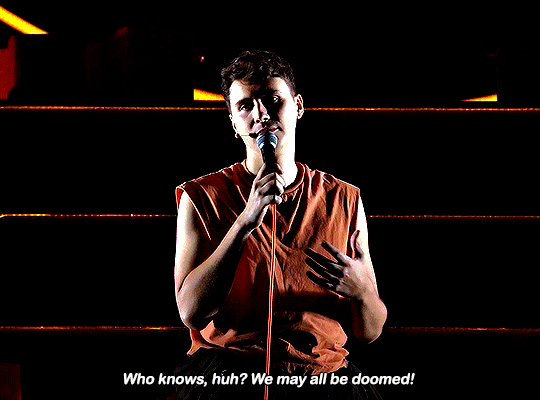
Oh Creator did I have to dig deep into my brain for this term of articulators. So my directing instructor had some key terms that I think I don’t think are universally used, even by American theatre directors or at least in academic settings. She defined articulators to basically be elements that helped give almost like checkpoints for the progression of a throughline in a show. For WAD, that is easily those orange cubes.
When static is displayed on the Circle’s screen each time we transition to a new section, it is not the typical emulation of TV static, it is that sea of orange squares. It is an articulation of those fear, issues, concerns, all those pinpoints Dan speaks to why he says “We’re All Doomed”.
That’s why there is the culmination of the orange cubes falling on him, when he reaches the top of the stairs at the end of Act One. When he circles back to the same stage picture of him at the top, it can been considered a repetition of the prophetic imagery I pointed out from the opening sequence. What changes is that the orange squares enter the physical world, falling onto Dan. He can no longer say they live in his head. They are here and stay in the space until the end of the show. In Act One, they are the looming issues that signal the Apocalypse. In Act Two, they are the rubble that must be sorted through.

Calvina was the one who named it rubble and the cubes as representations of Dan’s problems. To have the audience actually able to take a cube home, she argued, would be symbolic of the audience helping carry that weight. While I’d love that, I mentioned in my tags on her post that I think mentally, that rubble would still be at his feet, even with taking home that visual metaphor. This is Dan we’re talking about, and with personal responsibility being a topic of the show, while it’s not his burden to bear alone, he does have to recognize it exists.

I think the repetition of the prophetic imagery comes to its climax when in the aftermath found in Act 2, voting who to fire into space can and does end up with him being sent by the audience. It represents an understanding of where he exists now from where he did at 18 in terms of social, political, and economic access and the possibilities of his influence. There is a responsibility there that ties to how he can move in the world now publicly, so why wouldn’t he have an existential crisis?


--
It is a Comedy Though, Right?
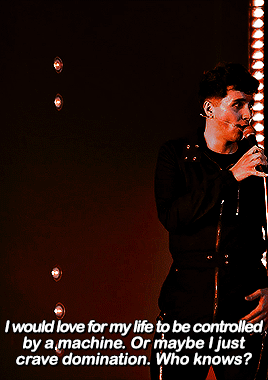
This is hundred percent comedy, and obvious dark humor at that. As a director, I love comedy, especially this type, because when an audience gets to laugh, the armor gets stripped away. They have no built-up resistance that let’s any uncomfortable point be heard effectively. It’s why the end’s vulnerability is effective, because we have already joked and laughed about our pains and our desire for escapism. Now we are able to move on into a place of reflection.
To underline why I say this is not stand-up comedy is that Dan has made it a stage show, just one that has comedy as a vehicle for telling this “story”. His interactions with his audience, through both quips based on audience reactions or “heckling” as well as explicitly asking for input into who to shot to space or what to add as a mad lib (generic brand for law purposes), are about being blended into the loose narrative constructed already, not actually to be reactionary like most crowd work I associate with stand-up comedy.
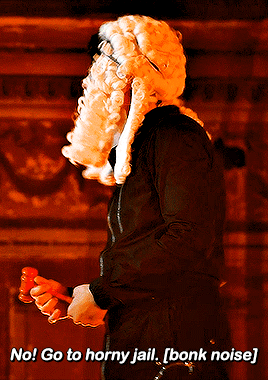
If anything, I could argue that it could be considered a comedy special that “Dan On Stage” is trying to make, but there is actually conflict being introduced that disrupts his set (both the comedy one and the physical one). There is clearly a showing of meta, as Dan makes sure to share thoughts on the creation of the show, the reactions from his overall show branding & imagery, the use of the lift because it was expensive to have. Dan’s comedy style can never be told without reference to behind the scenes, because if this is a creative means to process feelings, there are things about the show & its making that impact what needs to be processed too. It is also related to how his work is strengthened by acknowledging the two-way street of being in a parasocial relationship with his audience.
--
Can We Have One Good Night?

Another term central to what my directing teacher spoke of was the “Core”, usually a question, though not always, that motivated what was being explored over the course of a theatre piece. At the top, as Dan on Stage exaggerates that love doesn’t exist (which Dan refutes as being an actual belief of his during the afterparty) and other sardonic phrases, he also states he wants to give his audience one good night, because he recognizes the escapism his audience finds in his solo and joint content. We’re All Doomed’s Core is “can we just have one good night, even in the midst of the horrors we have outside of these theatre doors?”. But I would also say that in terms of where his writing was at the time of WAD’s inception and the naming of his mental health book as You Will Get Through This Night, it feels more like Dan himself has been grappling with a Core of “can I have one good night? Or a full 24 hours where I feel mainly happy when all I am bombarded with about the world is suffering?” I think night can be both literal, since we know he has had sleep issues, and metaphorical, as the night can represent this depressive episode he was writing himself out of.
When the mood tracker gets discussed in the last portion of WAD, to see a sea of neutral or uninterested emojis demonstrates when he took the time to do it, the answer that night was “no, not really” 😕. The main one mentioned is the ritual of “Fry Day” he has with Phil (sidenote: why are these British men not calling it “Chip Day”, since this ritual falls on a Saturday?), which is a rare smiley face. The question he likely has then is “can I ever have a good night again?”
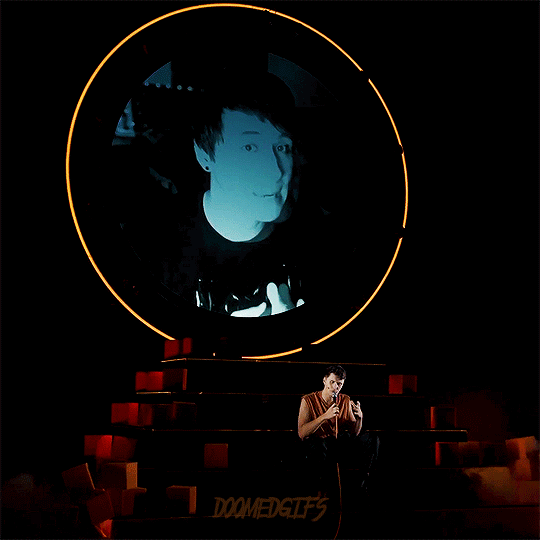
So for him to then turn to his own videos during one of those nights, to a video where he states his famous “embrace the void and have the courage to exist,” that showcases what I mentioned of his best work being written for himself, in this case, a future version of himself.
--
Ending Sequence: Where Do We Land?

When the Circle does not display any media, it again shows the orange square motif, but after mentioning his own video, he turns to his audience for glimpses of what joy exists even in the face of Doom. The Circle changes into a display of different submitted clips showcasing this joy and hope that Dan was clearly looking for throughout this piece. He walks towards the top of the stairs to witness these clips. I cannot for my life at this point having now been separate from it for about a month, but I believe before the submitted media sequence, he states the famous line again of “Embrace the Void and Have the Courage to Exist”. With this last thing spoken, it gives that emphasis needed to take in the message emotionally and then witness what the Void (in this case the Circle) can offer.
--
A Good Director Should Go Unnoticed
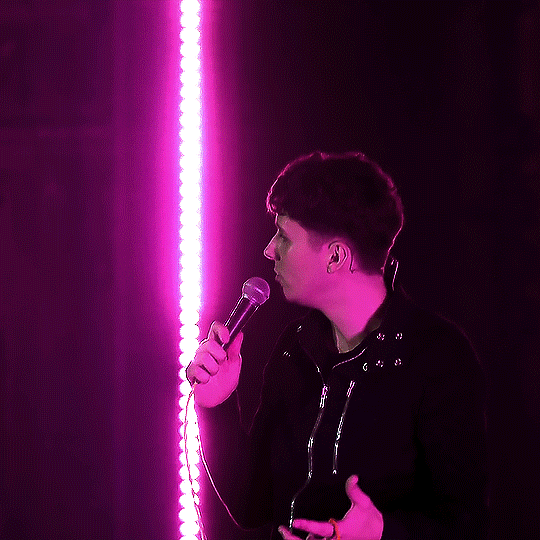
When someone is not versed in theatrical directing, if the audience cannot tell what was a choice by the director or even consider the director themselves, this is weirdly a good sign. It means that it feels natural to what they are witnessing and to the messages that are meant to be communicated to the audience. As someone who also works in government, it feels very similar, as only bad work is evident to the general public. Obviously that is not true for everyone, but is an overall trait I think impacts both an understanding of public service and directing.
I am not familiar with any of the work of Ed Stambollouian, who through research, looks like he has done work with comedians like Joe Lycett (who I am also not familiar with) and directed TATINOF, but also more stripped down, exploratory theatre. Through a quick review of his portfolio, one, I am not shocked that Dan tapped him to assist with directing since there is a familiarity and two, his background tells me he knows how to direct for writer-performers, which is what comedians really are at the end of the day.
To direct for those who are doing one-person shows that they both wrote and performed, it is especially tricky to have the artist hand the reins over to the director. The director in this case acts as the artist’s eyes, because an artist cannot clone themselves. It is impossible for them to wear multiple hats at once, where they can give quality, objective feedback to themselves while also doing a full out performance. For Ed to be someone Dan has worked with before, there is already an established understanding of each other’s work styles, and a trust that otherwise would have to be built up before the work can truly begin to finalize the piece.

In short, Ed Stambollouian and the creative team on We’re All Doomed did an incredible job bringing what I understand Dan intended when he started writing this down in isolation. And @danielhowell you whole-heartedly deserve to call this your magnum opus. What can I say (sorry I can't help lovingly poking fun at you), your artistry shines throughout the show. I hope this too can be something your future self can turn back to.
🧡

(bonus) Thoughts on Orange Carpet & the Phil element
I didn’t fully rewatch the orange carpet, just to keep myself on task & not bring Phil too much into the main reflection without explicit reference in the show, but hearing Dan go “I’m alive in 3, 2…” made me laugh both times. He understands that we just want to know he has a pulse, ya know? Also them pretending it totally was live, when those fools (affectionate) cannot run a real live broadcast from their home for their lives. It just ran too smoothly, esp. in the transitions, for it to be anything but some very, very light editing on one improvised take they did. But I always support them in their acting, no matter how bad, like with DITL Australia’s opener or pretending there were not two apartments or that Google Feud being back was unplanned or Dil being pregnant with a statistically rare alien child or Phil living in a tiled, cramped bedroom or...
Also, Dan’s little laugh at the end of Phil’s sign-off is so fond it hurts. It also hurt that the VOD was hard to scrub through, so another deduction for the Kiswe platform.
Anyway, I’m glad that Dan was able to find space outside of the Dan & Phil branding of the 2010s as well as the image he was forced to manufacture for his YouTube presence, but also realize that with having a core audience that wants him to simply be happy, he can recognize that Phil is part of the things that make him happy. And can do so openly.
He is his own person, but it has been clearly emphasized now that Dan has no interest in not acknowledging that Phil always is and will be part of his present and future. He has made work like WAD & "Gay and Not Proud" to explore his way of thinking without the support of Phil present in the filmed/performed aspect. Dan acknowledges this intention, which is evident with him shooing away Phil at the beginning of “Gay and Not Proud” to process it alone.

It is also evident with the ending of “Daniel & Depression” and the WAD end credit of remote crisis manager showcasing the caretaking role Phil often plays in Dan’s life. But we know that caretaking is reciprocal, considering Phil's tactics with glue as well as his continuing health issues and anxieties. Dan has seen who he is without Phil by his side everyday in the public eye & has no interest in maintaining that Phil is absent for public projections.
I obviously do not know Dan Howell, or anything about him outside what exists on the internet. But in performance studies, there is a foundational understanding that there is no way to not be performing in some way during your day-to-day. Performing is not inherently a bad thing, as there are different roles you take on in your life, where how I engage at work is different from how I am hanging out with friends. This also has basis in gender studies, such as ideas that you can perform your gender "wrong". What has been so interesting to me in this phandom renaissance is the way Dan and Phil each perform as themselves in front of the camera now. What they share out and the layers they include--or choose to not remove--have been stated by them explicitly to be the most authentic they have ever been, without obviously removing their right to privacy. During the height of the glass closet that was their 2018 content, I remember thinking that it was going to be the most they would show us in the vain of "if you know, you know, and we know who will know". After the coming out videos of 2019, obviously that's not true, but the return of dapg has signaled a message of "we know you know, if you've been in the know" while veiled in a way that is not immediately perceivable by those who are casually engaging with their content. It is an authentic portrayal of themselves without filter, while also providing themselves space to not have to announce everything to the world. When you are in the know, it definitely targeted and causes psychic damage, but I am ready for anything and everything they throw our way.
#we’re all doomed#wad spoilers#daniel howell#danisnotonfire#dnp#dan and phil#dan howell#theatre analysis#performance studies#theatre director
69 notes
·
View notes
Text
Hey, everybody? Especially performers? This your friendly reminder to respect your stage crew/manager during the process of performing a show.
As somebody who has worked both as an actor and as a stage manager, stage crew have the hardest job in the show. Most of the time, in my experience, we are only brought onto the show about the week beforehand, which means we have maybe 4-6 days to memorise all of the props, set pieces, and sometimes light and sound cues. Do you understand how difficult that is?
We have the full weight of the show on our shoulders sometimes, being the ones who have to remind people their lines, running into the dressing rooms to find people before they're late for their cues, and on a few occasions, having to fix set pieces with minimal supplies moments before they go onstage. Let me tell you, that's fucking stressful.
And then for members of the cast who should definitely know better to disrespect us, sometimes to our faces, like we did nothing all show? Have you ever heard someone say "They're bit useless, aren't they?" after you ran halfway across the theatre to find a prop somebody moved with two minutes until it was needed? I have, and trust me, it seriously sets a downer on you for the rest of the show.
Are we a bit bitchy sometimes? Absolutely. But you would too if you're on the verge of tears from stress and have people constantly talking about how terrible or useless you are. We definitely have an excuse.
TLDR, You do not have the right to bully your stage crew when they are the whole reason your show is still up and running.
#sorry for the serious post#but i saw a post where somebody was talking about how annoying their stage manager was and i wanted to scream#like guys#this should be common sense#dont talk shit about the people who are holding your show together#without us#you would not be performing.#do not fucking disrespect us.#thank you!#theatre#musical theatre#stage crew
65 notes
·
View notes
Text
157 notes
·
View notes